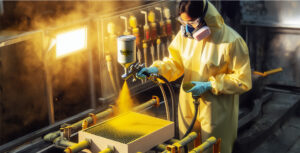Aesthetic Enhancements with Powder Coated Surfaces
Powder coating is not just about durability; it significantly enhances the aesthetics of exterior panels. With its smooth, even finish, powder coating can be produced in a vast array of colors and textures. This versatility allows designers and architects to achieve specific visual effects, whether it’s a glossy, matte, metallic, or even a textured finish. The richness and depth of the colors achieved through powder coating are unparalleled, making it a preferred choice for projects where aesthetic appeal is paramount. Furthermore, powder coating can be applied to a variety of materials, including metals, plastics, and wood, providing a uniform and high-quality finish across different surfaces.
Comparative Analysis: Powder Coating vs. Traditional Paint Methods
When compared to traditional paint methods, powder coating stands out for both its environmental and performance benefits. Traditional liquid paints often contain solvents, which release volatile organic compounds (VOCs) into the atmosphere, contributing to pollution. Powder coating, on the other hand, contains no solvents and releases negligible amounts of VOCs, if any. In terms of performance, powder coating is more durable than liquid paints, offering better protection against chipping, fading, and scratching. It also adheres more effectively to surfaces, providing a long-lasting finish. The efficiency of the application process in powder coating reduces overspray and waste, making it a more sustainable choice.
Durability and Longevity of Powder Coated Finishes
Powder coated finishes are renowned for their durability and longevity. The coating forms a hard, protective layer that is more resistant to scratching, chipping, and fading compared to traditional paint finishes. This durability extends the life of the coated object, reducing the need for frequent maintenance or replacement. Powder coating is particularly resistant to harsh weather conditions, including UV radiation, moisture, and extreme temperatures, making it ideal for outdoor applications.

The Role of Powder Coating in Sustainable Construction Practices
Powder coating aligns well with sustainable construction practices. Its low VOC emissions contribute to a healthier environment by reducing air pollution. Additionally, the efficiency and minimal waste in the powder coating process align with the principles of sustainable construction. The durability of powder coated finishes means less frequent replacements and repairs, conserving resources and reducing waste over time. By extending the lifespan of materials, powder coating supports the principles of sustainability in construction.
Technical Insights: The Powder Coating Process
The powder coating process involves several key steps. Initially, the surface to be coated is thoroughly cleaned and prepared to ensure effective adhesion. The powder, which is a mixture of finely ground particles of pigment and resin, is then electrostatically sprayed onto the surface. The charged powder particles adhere to the electrically grounded surface until heated and fused into a smooth coating in a curing oven. This process results in a uniform, durable, and high-quality finish.
Innovations in Powder Coating Technology for Exterior Applications
Recent innovations in powder coating technology have expanded its applications, particularly in exterior environments. These advancements include the development of more environmentally friendly formulations, such as low-cure powders that require less energy to process. Technological improvements have also led to powders that can adhere to a broader range of materials, including heat-sensitive substrates. Additionally, advancements in color and texture options provide even greater possibilities for aesthetic expression and design flexibility in architectural applications.
Cost-Benefit Analysis of Powder Coating for Building Exteriors
A cost-benefit analysis of powder coating for building exteriors reveals several advantages. While the initial cost of powder coating can be higher than traditional paint, the long-term savings are significant. The durability of powder coating means less frequent maintenance and repainting costs. The efficiency of the application process and minimal waste generation also contribute to cost savings. Additionally, the aesthetic appeal of powder-coated surfaces can enhance the value of a building.
Case Studies: Successful Powder Coating Projects Worldwide
Various global projects have successfully utilized powder coating for their exterior panels. These case studies demonstrate the versatility, durability, and aesthetic appeal of powder coating in different climates and environments. Examples include high-profile architectural projects, transportation infrastructure, and public art installations. These projects highlight the effectiveness of powder coating in enhancing both the visual appeal and lifespan of exterior structures.
